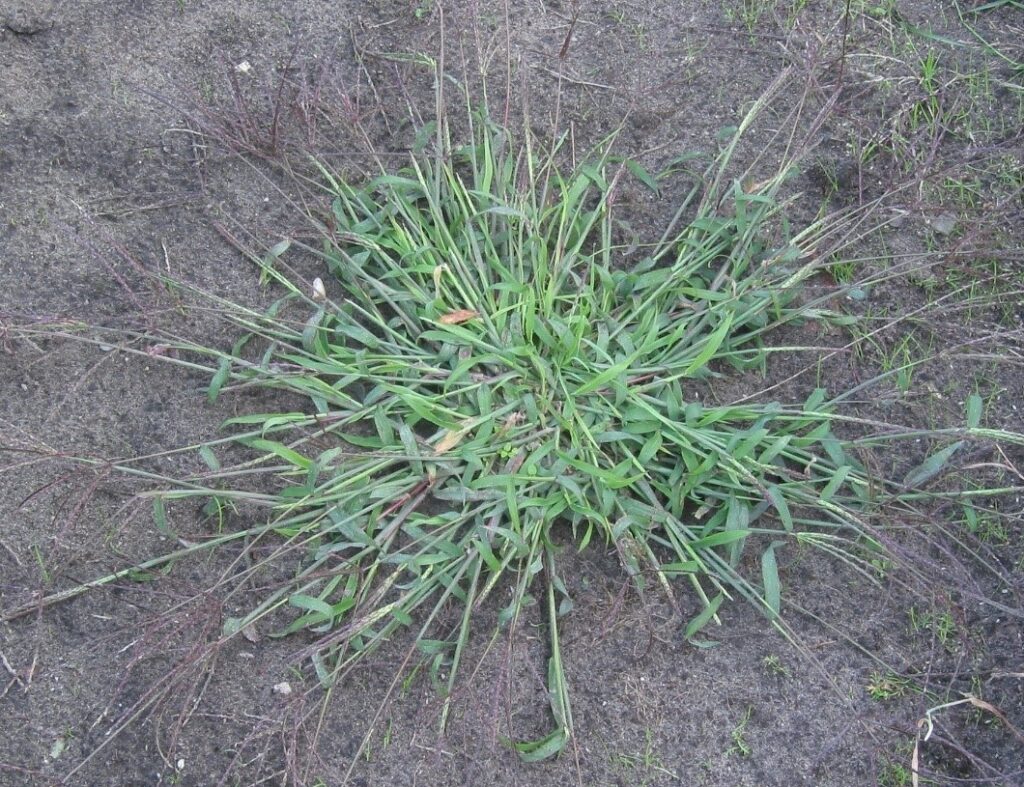Table of Contents
ToggleLast Updated on April 20, 2025
What is Crabgrass?

Why does Crabgrass grow in my lawn?
Crabgrass is typically found in stressed areas of lawns that are thin, bare, and have poor growth. Common examples of these areas are along curb edges, driveways, and walkways. It favors these areas because these types of areas are hit hardest by stress throughout the season. That being said, even a well-maintained lawn can still have annual issues with crabgrass.
What options are available for Crabgrass prevention and control?
There are many options available for crabgrass prevention and control. Here are some helpful tips to help you this season:
- Crabgrass prevention can be accomplished by apply a crabgrass pre-emergent every year. Crabgrass pre-emergent needs be applied in the early spring season (March & April) and it is also recommended to complete two treatments. The second treatment should be applied 6 to 8 weeks after the first treatment and is meant to reinforce the initial treatment and increase the duration of the product into the summer season. Crabgrass pre-emergent products typically lasts in the soil for about ten to twelve weeks depending on site conditions and cultural practices. A crabgrass pre-emergent creates an invisible barrier in the soil and controls the plants once they cross the barrier. For more information on how pre-emergents work, follow this link to our Landscape Bed Weed Control Blog. Try not to disturb the soil after the crabgrass pre-emergent has been applied. If the barrier becomes compromised (core aeration, dethatching, seeding, construction, etc.), crabgrass will most likely emerge in these areas. Because crabgrass is very similar to desired grass species, the pre-emergent will also control any new seeding you may have completed. For this reason, (and many others), spring seeding is not recommended.
- Once the crabgrass plant has emerged, it’s too late to apply any pre-emergent controls. This is where a post-emergent crabgrass control will come in handy. Post-emergent crabgrass controls are applied as a liquid, directly to each plant. This will control the crabgrass plants after they’ve already started growing above ground. A post-emergent crabgrass control will NOT prevent new growth of crabgrass nor will it control actively growing broadleaf weeds.
- Keep the lawn thick for additional help with crabgrass prevention. Any bare or thin areas should be seeded in late summer. A dense lawn not only helps shade the soil, keeping it cooler, but it also provides less space for the crabgrass plants to grow. See steps 6-9 below for additional tips on keeping the lawn thick. All of the following steps will not only help with crabgrass prevention, but also improve overall health of your turf.
- When mowing the lawn, keep the grass blades at a height around 3 – 3 ½ inches and only cut off 1/3 of the grass blade at a time. Keeping the canopy of the grass tall will help shade the soil beneath, keeping it cooler which will help reduce crabgrass from germinating.
- Edges of driveways, walkways, patios, pools etc., typically get cut too short with a weed wacker. In addition, uneven ground can result in short mowing heights or even scalping. Both scenarios are problematic when it comes to crabgrass prevention and control. Scalping weakens the grass plant and makes it more susceptible to injury and death when stressed. Once turf grass is in decline and more of the soil is exposed to sunlight, crabgrass seeds can germinate in those areas. Be extra careful mowing uneven areas and using the weed wacker along the edges to avoid cutting your turf too short.
- Water. Watering will not only help improve color but will aid in growth as well. By watering correctly early in the season, and continuing thru August, you will be promoting good turf growth which will make it difficult for crabgrass plants to move in.
- Fertilize regularly. Fertilizing on a regular basis will help stimulate growth and create a thicker lawn. When the lawn is thick and vigorously growing, it will shade the soil and create more competition against the crabgrass plants. A thick and healthy lawn is a great way to help with crabgrass prevention.
- Core aerate the lawn annually. Crabgrass thrives in compacted soils. By core aerating regularly you are creating better soil conditions. This also helps improve water and nutrient movement to the roots, resulting in a stronger root system and healthier lawn.
- Lime the lawn if the pH of the soil is low. The pH is the measure of the alkaline or acidity of the lawn soil. When the pH is in the proper range (6.3 – 6.5) the lawn will utilize all of the nutrients it gets during the year, creating a healthier, stronger and vigorously growing lawn. For more details on Soil pH, here is a link to our pH and Lime blog.
Conclusion
Don’t let crabgrass become a pain in your grass! The steps above will not only help you with crabgrass prevention and control, but they also promote a healthier lawn. With the tips above, you and your lawn professional can reduce crabgrass and make your lawn look beautiful for years to come. If you are in our service area or have any questions, feel free to contact us at 908-281-7888 or visit our website at www.fairwaygreeninc.com

